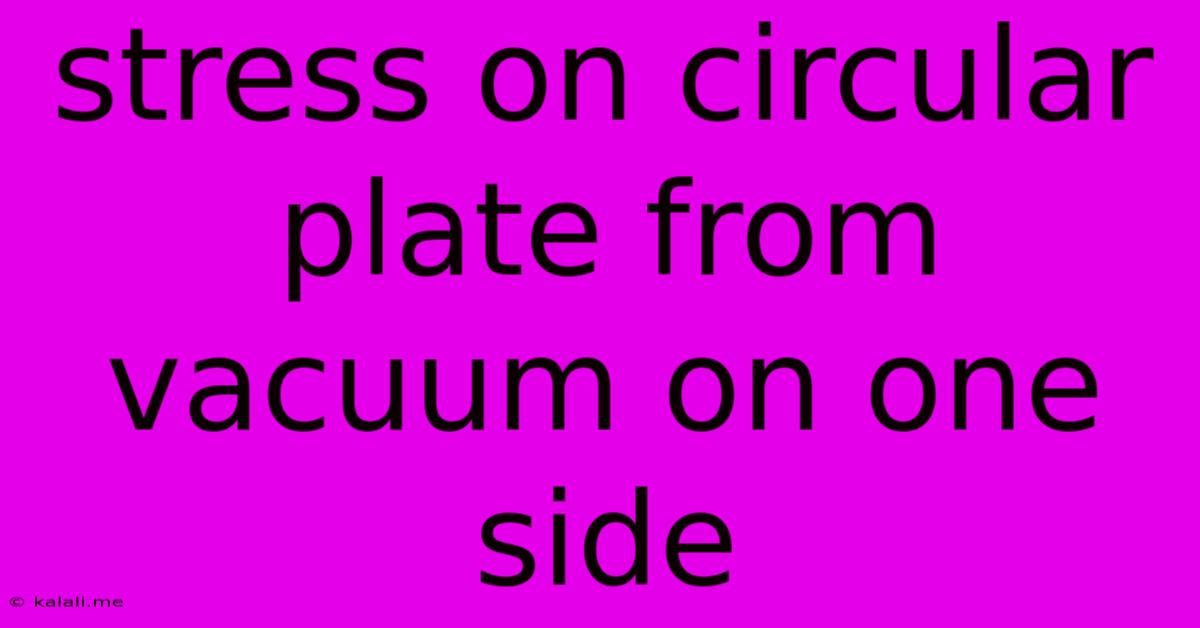Stress On Circular Plate From Vacuum On One Side
Kalali
Jun 02, 2025 · 3 min read

Table of Contents
Stress on a Circular Plate Due to Vacuum on One Side
This article explores the stress distribution within a circular plate subjected to a vacuum on one side. Understanding this phenomenon is crucial in various engineering applications, from designing vacuum chambers to analyzing pressure vessels. We'll delve into the theoretical calculations and practical considerations involved. This analysis is particularly relevant for applications involving thin plates where bending effects become significant.
Understanding the Problem:
Imagine a thin, circular plate with a uniform thickness. When a vacuum is applied to one side, a pressure difference is created between the two surfaces. This pressure difference generates a net force acting on the plate, causing it to deform and experience internal stresses. The magnitude of these stresses depends on several factors, including the plate's material properties (Young's modulus and Poisson's ratio), its geometry (radius and thickness), and the pressure differential created by the vacuum.
Theoretical Analysis:
The analysis typically involves using classical plate theory, specifically considering the effects of bending. The governing equation, derived from equilibrium considerations and constitutive relations, describes the relationship between the applied pressure and the resulting deflection of the plate. Solving this equation, often through numerical methods for complex geometries or boundary conditions, allows us to determine the stress distribution.
Key Considerations:
-
Boundary Conditions: The manner in which the plate is supported significantly influences the stress distribution. Common boundary conditions include clamped edges (fixed displacement and rotation), simply supported edges (fixed displacement but free rotation), and free edges (no constraints). The stress concentration is usually higher near fixed edges.
-
Plate Thickness: Thicker plates are more resistant to bending and consequently experience lower stresses compared to thinner plates under the same vacuum pressure. This is due to increased bending stiffness.
-
Material Properties: The material's Young's modulus (a measure of its stiffness) directly affects the plate's resistance to deformation and the resulting stresses. A higher Young's modulus leads to lower deflections and stresses. Poisson's ratio, which describes the material's tendency to deform in directions perpendicular to the applied load, also influences the stress state.
-
Vacuum Pressure: The magnitude of the vacuum pressure is directly proportional to the stress experienced by the plate. A higher vacuum pressure will result in higher stresses.
Stress Components:
The stress state within the plate is complex and involves multiple components. These typically include:
- Radial Stress: The stress acting in the radial direction (along the radius of the plate).
- Tangential Stress (Circumferential Stress): The stress acting tangential to the plate's circumference.
- Bending Stress: Stresses generated due to the bending of the plate under the vacuum load. These stresses are particularly significant in thin plates.
- Shear Stress: Stresses due to the shear forces developed within the plate.
Numerical Methods:
For complex scenarios involving non-uniform pressure distributions or intricate boundary conditions, numerical methods like Finite Element Analysis (FEA) are often employed. FEA allows for precise determination of the stress and displacement fields within the plate.
Practical Applications and Considerations:
Understanding the stress on a circular plate under vacuum is vital in designing various engineering components, including:
- Vacuum Chambers: Ensuring the structural integrity of vacuum chambers requires accurate stress analysis to prevent catastrophic failure under vacuum conditions.
- Pressure Vessels: Similar considerations apply to pressure vessels operating under significant pressure differentials.
- Microelectromechanical Systems (MEMS): In MEMS devices, thin membranes are often subjected to pressure differentials. Accurate stress analysis is essential for reliable device operation.
Conclusion:
Analyzing the stress distribution in a circular plate under vacuum involves a careful consideration of several factors. Understanding these factors and utilizing appropriate analytical or numerical methods is crucial for designing safe and reliable structures in a wide range of engineering applications. Further research could explore the effects of imperfections or non-uniform thicknesses on the stress distribution and failure mechanisms.
Latest Posts
Latest Posts
-
Can U Color Potions In Minecraft
Jun 04, 2025
-
Difference Between Fourier Series And Fourier Transform
Jun 04, 2025
-
How Much Weight Can A Floor Hold
Jun 04, 2025
-
I Can Fly But I Have No Wings
Jun 04, 2025
-
Are T8 And T12 Led Bulbs Interchangeable
Jun 04, 2025
Related Post
Thank you for visiting our website which covers about Stress On Circular Plate From Vacuum On One Side . We hope the information provided has been useful to you. Feel free to contact us if you have any questions or need further assistance. See you next time and don't miss to bookmark.